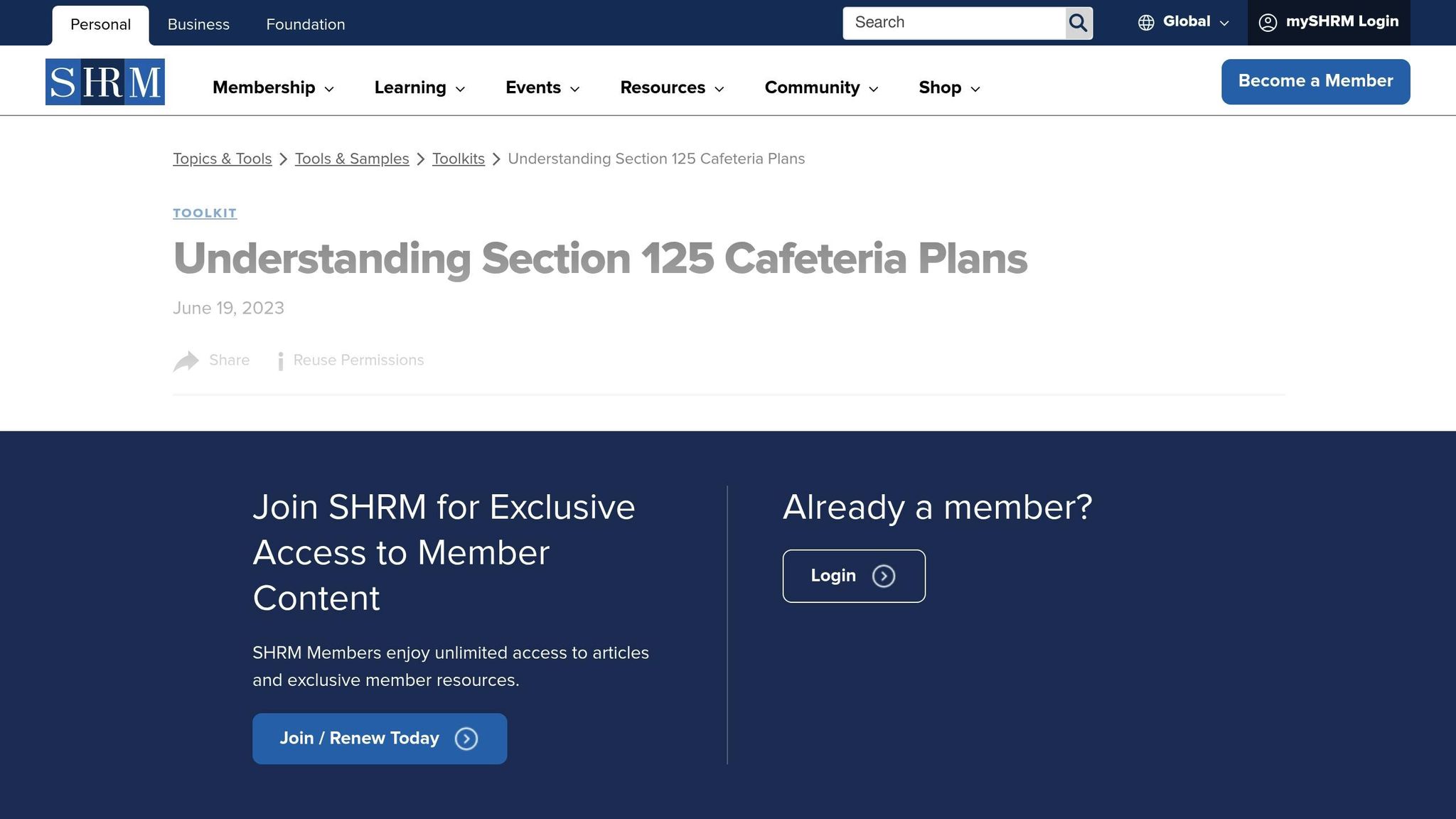Navigating employee benefits? Offering HSA matching contributions can be a smart move for employers. Here’s why:
- Tax Advantages: Employer contributions are tax-deductible and exempt from federal income tax, FICA, and FUTA. Employees also enjoy tax-free contributions and withdrawals for medical expenses.
- Employee Ownership: HSA funds belong entirely to employees and are portable – ideal for long-term savings.
- Encourages Participation: Matching boosts employee contributions by 14% on average and increases adoption rates by 11%.
- Compliance Options: Using a Section 125 cafeteria plan avoids excise taxes and offers flexibility in contribution strategies.
Other options like HRAs and FSAs provide tax benefits too but differ in ownership, rollover rules, and administrative complexity. HRAs are employer-controlled but lack portability, while FSAs require careful planning due to "use-it-or-lose-it" rules.
Key Takeaway: HSA matching stands out for its triple tax benefits, simplicity, and long-term value for employees. However, employers should assess workforce needs and compliance rules to choose the best fit.
You Can Now Choose Between 401K or HSA Employer Match
1. Employer HSA Matching Contributions
Employer HSA matching happens when companies contribute to their employees’ Health Savings Accounts (HSAs), matching the amount employees put in. Unlike some other benefits, HSAs are owned entirely by the employee from the start – there are no vesting schedules or forfeiture rules to worry about.
How the Tax Benefits Work
Employer contributions to HSAs come with significant tax advantages. These contributions are exempt from federal income tax, Social Security (FICA), Medicare, the Federal Unemployment Tax Act (FUTA), and, in most cases, state unemployment taxes. This applies whether the contributions are made directly or through a Section 125 cafeteria plan.
For employees, the tax perks are equally appealing. Any amount contributed by an employer is excluded from the employee’s gross income, meaning it doesn’t count as taxable income.
The Section 125 Advantage

Using a Section 125 cafeteria plan for HSA contributions gives employers more flexibility. It allows for tailored programs like matching contributions, wellness incentives, or varying contribution amounts – all while avoiding a hefty 35% excise tax.
On the flip side, contributions made outside of a Section 125 plan must follow strict comparability rules. These rules demand that all employees in a specific category receive the same dollar amount or the same percentage of the high-deductible health plan deductible. If these rules aren’t met, the employer faces that same 35% excise tax.
Contribution Limits and Employee Impact
Employer contributions count toward an employee’s annual HSA contribution limit. Companies that contribute to HSAs see an 11% higher adoption rate among employees. Plus, when employers contribute, employees tend to add an average of 14% more to their own HSAs. This shows how matching programs can encourage better participation and savings habits.
Employees also save about 30% on eligible medical expenses by using HSA funds. These savings, combined with the portability and employee control of HSAs, make them a highly attractive benefit.
Account Ownership Rules
Once an employer contributes to an HSA, the funds belong entirely to the employee. If the employee leaves the company, the HSA – and all the money in it – goes with them. This portability makes HSAs a long-term benefit that employees can rely on throughout their careers.
2. Health Reimbursement Arrangements (HRAs)
Health Reimbursement Arrangements (HRAs) stand apart from Health Savings Accounts (HSAs) in terms of tax treatment and ownership. With HRAs, employers hold more control, while employees have less flexibility.
Tax Treatment for Employers and Employees
For employers, contributions to HRAs are fully tax-deductible as a business expense. These contributions are exempt from federal income tax, Social Security, Medicare, and unemployment taxes, making HRAs an appealing choice from a cost perspective.
Employees benefit from tax-free reimbursements for qualified medical expenses. Since these funds aren’t counted as taxable income, employees receive the full amount without worrying about taxes. However, unlike HSAs, HRAs are solely funded by employers – employees cannot add their own money to the account. This distinction shapes how these accounts function and their level of flexibility.
Account Ownership and Portability
HRAs are entirely owned by the employer. If an employee leaves the company, they usually lose access to any unused HRA funds unless the employer offers continuation coverage.
This employer ownership also means companies set the rules on fund rollover and forfeiture. Some employers allow unused funds to carry over to the next year, while others enforce a "use it or lose it" policy. Because HRAs lack portability, they don’t offer the same long-term financial benefits as HSAs.
Spending Limits and Plan Design
HRAs provide flexibility in spending limits. Employers can set annual maximum contributions based on their budget, ranging from a few hundred to several thousand dollars. Unlike HSAs, HRAs don’t have federally mandated contribution limits, giving companies more freedom to tailor their plans.
Employers can also structure HRAs to complement existing health coverage. For instance, Individual Coverage HRAs (ICHRAs) reimburse employees for individual health insurance premiums, while Qualified Small Employer HRAs (QSEHRAs) are designed specifically for small businesses with fewer than 50 employees. This adaptability allows companies to align their HRAs with their overall benefits strategy.
Administrative Requirements
Managing HRAs requires more oversight compared to HSAs. Employers must track expenses, process reimbursements, and maintain detailed records to meet tax and compliance requirements. This often leads companies to hire third-party administrators to handle claims and ensure proper documentation.
For employees, the process involves submitting receipts for approval, which adds an extra layer of effort compared to the convenience of HSA debit cards. While this creates a more controlled system, it also increases the administrative workload for both employers and employees.
sbb-itb-a729c26
3. Flexible Spending Accounts (FSAs)
Flexible Spending Accounts (FSAs) provide a unique way to manage healthcare expenses, offering tax advantages for both employers and employees. However, they come with specific rules and limitations that require careful consideration to maximize their benefits.
Tax Advantages for Employers and Employees
FSAs deliver notable tax perks. Employers can often deduct their contributions as a business expense and benefit from reduced payroll taxes on employee contributions. For employees, the money they allocate to an FSA is deducted from their salary before taxes, lowering their federal income, Social Security, and Medicare tax obligations. This setup can result in immediate savings, though the exact amount depends on the individual’s tax bracket.
Contribution Rules and Limits
FSAs have strict contribution limits set annually by the IRS, which are lower than those for HSAs. Both employer and employee contributions count toward this cap. One standout feature of FSAs is their "all or nothing" funding model. Employees have access to their full elected amount at the start of the plan year, which is helpful for covering large medical expenses early in the year. However, this also requires careful planning to avoid losing unused funds at the end of the year.
The "Use-It-or-Lose-It" Rule and Rollover Options
One of the biggest challenges with FSAs is the "use-it-or-lose-it" rule. Any unused funds at the end of the plan year are typically forfeited. Some employers may offer a grace period or allow a limited rollover of unused funds, as permitted by IRS rules. While these options provide some leeway, employees need to accurately estimate their healthcare expenses to avoid losing money.
Administrative Challenges and Compliance
Managing FSAs can be complex. Employers must ensure that reimbursements are strictly for qualified medical expenses and maintain detailed records for tax compliance. If an employee leaves after using more FSA funds than they’ve contributed, the employer must reconcile the overage. Many businesses turn to third-party administrators to handle claims processing and compliance tasks. In Illinois, companies can consult local experts like Illinois Health Agents for tailored advice on managing these accounts effectively.
Different Types of FSAs
Employers can offer variations of FSAs to meet diverse employee needs. For example, Dependent Care FSAs allow pre-tax contributions for childcare or elder care expenses. Limited Purpose FSAs are designed for employees with HSAs and typically cover only dental and vision costs until certain high-deductible health plan thresholds are met. Offering these options helps employers create benefit packages that cater to a wide range of employee circumstances.
Advantages and Drawbacks
Each benefit option – HSA matching, HRAs, and FSAs – comes with its own set of tax and administrative considerations. Employers need to weigh these factors carefully to create a benefits strategy that aligns with both their goals and their employees’ needs.
| Feature | HSA Matching | HRAs | FSAs |
|---|---|---|---|
| Tax Treatment | Triple tax benefit: deductible contributions, tax-free growth, and tax-free withdrawals for eligible expenses | Employer contributions are tax-deductible; employee reimbursements are tax-free | Pre-tax employee contributions lower payroll taxes; employer contributions may also be deductible |
| Annual Contribution Limits | Set by the IRS and vary by individual or family coverage | Determined by the employer | Set annually by the IRS |
| Rollover Policy | Funds roll over and stay with the employee | Employer decides; typically, funds don’t roll over | Limited rollover or grace period may apply |
| Employee Ownership | Fully owned by the employee and portable | Employer-owned; unused funds may not transfer if employment ends | Employer-controlled; unused funds are often forfeited |
| Investment Growth | Can be invested for long-term growth | No investment option | No investment option |
| Administrative Complexity | Moderate, with compliance tied to high-deductible health plans | Higher due to claims processing and plan design | Higher because of "use-it-or-lose-it" rules and compliance requirements |
The table above outlines the main differences, but let’s dig deeper into the strengths and challenges of each option.
HSAs offer a standout feature: triple tax benefits. Contributions are tax-deductible, the funds grow tax-free, and withdrawals for qualified expenses are also tax-free. Plus, employees can invest unused funds, making HSAs appealing for long-term savings. However, the requirement to pair HSAs with a high-deductible health plan might deter some employees who prefer lower out-of-pocket costs.
HRAs give employers the flexibility to design plans tailored to their budget and workforce. Employers control the contribution amounts and can retain unused funds, which helps manage costs. However, HRAs are employer-owned, meaning employees lose access to the funds if they leave the company. They also come with higher administrative demands, particularly when it comes to claims processing.
FSAs are a great fit for employees with predictable healthcare expenses. Contributions are made pre-tax, offering immediate tax savings. Employees also have upfront access to the full annual contribution amount at the start of the plan year. But FSAs come with a catch: the "use-it-or-lose-it" rule. Employees must carefully plan their contributions to avoid forfeiting unused funds, which adds a layer of complexity.
From an administrative standpoint, HSAs tend to be easier to manage once established, while HRAs and FSAs require more ongoing effort. Many employers in states like Illinois rely on brokers, such as Illinois Health Agents, to help navigate these complexities.
Employee preferences often depend on their life stage and financial goals. Younger employees are drawn to HSAs for their portability and investment potential, while those with predictable expenses often prefer FSAs. Employees nearing retirement may favor HRAs, which provide employer-funded support without requiring personal contributions.
Offering HSA matching can also be a strategic move for employers. It not only helps attract top talent but also boosts retention by making the overall benefits package more appealing.
Conclusion
HSA matching offers three key tax advantages: deductible contributions, tax-free growth, and tax-free withdrawals. Beyond these benefits, HSAs also serve as a tool for long-term investment growth, making them a valuable addition to a company’s benefits strategy.
However, implementing HSA matching requires careful planning. Employers need to ensure the accompanying high-deductible health plan complies with regulations. It’s also important to consider the unique needs of your workforce. For instance, younger employees may prioritize the portability and growth potential of HSAs, while those with higher medical expenses might need additional support. By analyzing compliance requirements and workforce demographics, businesses can create benefits strategies tailored to their employees.
For companies in Illinois, seeking professional advice can make all the difference. Illinois Health Agents specialize in crafting benefits packages that incorporate HSA matching alongside group health insurance solutions. Their expertise in employer contributions and tax-saving strategies helps businesses maximize their investment while addressing diverse employee needs.
Ultimately, the decision to offer HSA matching should align with your company’s objectives and the specific needs of your team. Done right, it can enhance financial wellness and help attract and retain top talent.
FAQs
How do HSA matching contributions compare to HRAs and FSAs in terms of ownership and portability?
HSAs offer a distinct advantage because they are employee-owned and portable. This means employees retain their HSA funds even if they switch jobs or leave their employer, making them a lasting and adaptable benefit.
On the other hand, HRAs (Health Reimbursement Arrangements) are employer-owned, meaning the funds generally stay with the employer when an employee departs. Similarly, FSAs (Flexible Spending Accounts) are also employer-controlled and often come with a use-it-or-lose-it policy – any unused funds may be forfeited at the end of the plan year.
Thanks to their portability and personal ownership, HSAs provide employees with more lasting value compared to HRAs and FSAs.
What do employers need to know about compliance when offering HSA matching contributions through a Section 125 cafeteria plan?
Employers that provide HSA matching contributions through a Section 125 cafeteria plan need to comply with nondiscrimination rules. These rules are designed to ensure all eligible employees receive contributions fairly, without giving preferential treatment to highly compensated employees. Meeting these requirements is crucial for staying in line with federal regulations.
One important distinction is that contributions made through a Section 125 plan are not subject to comparability rules, unlike those made outside of such a plan. However, employers must keep thorough documentation and follow all relevant federal guidelines to maintain the plan’s tax-qualified status. By understanding and adhering to these rules, employers can enjoy the tax advantages of offering HSA matching contributions while steering clear of compliance risks.
How can employers decide if HSA matching is the best fit for their team?
When deciding if HSA matching fits your company, start by examining your workforce’s specific needs and demographics. Factors like age, income levels, and healthcare usage can play a big role in how appealing and useful HSA contributions might be to your employees.
You’ll also want to think about your budget and ensure compliance with regulations, such as offering fair and equal contributions to all eligible employees. By tailoring HSA matching to align with both employee preferences and your company’s goals, you can build a benefits package that adds real value for your team and your business.



0 Comments